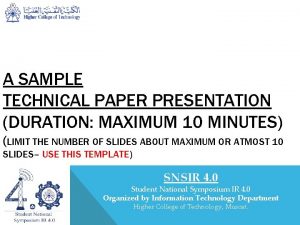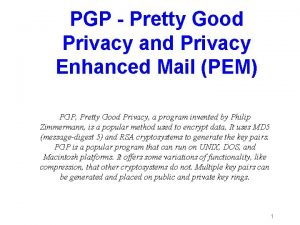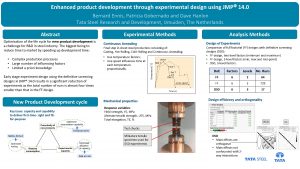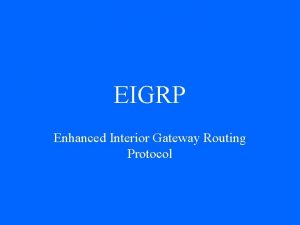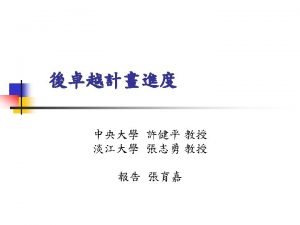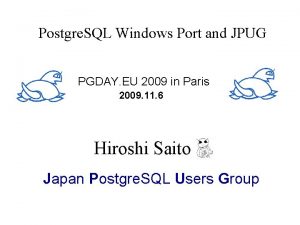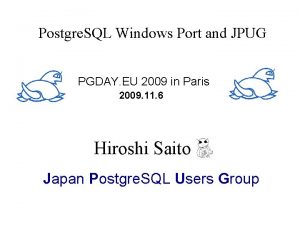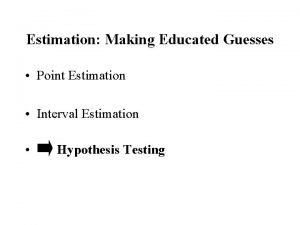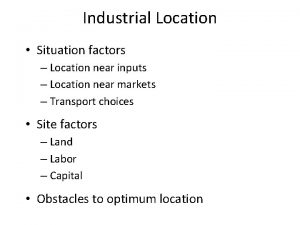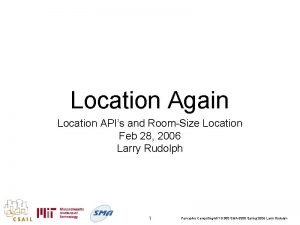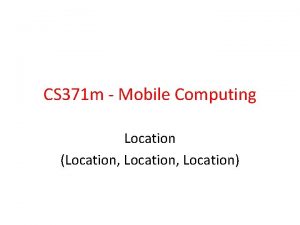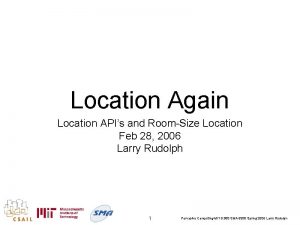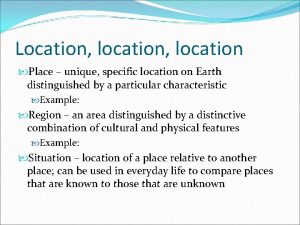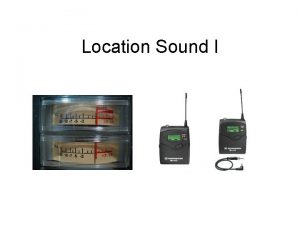PGDay Paper Presentation Enhanced Location Estimation in Wireless

























- Slides: 25

PGDay Paper Presentation Enhanced Location Estimation in Wireless LAN environment using Hybrid method Kevin C. Shum, and Joseph K. Ng Department of Computer Science Hong Kong Baptist University Kowloon Tong, Hong Kong cyshum, jng@comp. hkbu. edu. hk

Abstract Location Estimation in Wireless LAN (WLAN) environment become a importance part for network administrator to monitor the traffic within the network. Recent year, 2. 4 Ghz 802. 11(G/B) Wireless Router become more popular. Most of them can run an open-source firmware like dd-wrt, openwrt in order to obtain useful information like Received Signal Strength (RSS) for positioning. Programmable firmware like open-wrt for Linksys WRT 54 G is handy for us to store important Location Fingerprint (LF) and RF propagation loss model(PL) Location information into database, which helping network administrator to monitor the wireless network for surveillance purpose.

Introduction A programmable Linksys WRT 54 G burned with open sourced custom-made firmware is act as a wireless sensor in order to obtain information from the wireless environment, • Service Set Identifier (SSID) • Extended Service Set Identifier(ESSID) • Signal Strength (RSSI) and Noise Level A custom-made wireless data-retrieval application is written for the WRT 54 G, a cross-compiled binary for 32 -bit MIPS architecture processors manufactured by Broadcom is generating the best information to achieve our goals.

Requirements • • Server machine The database which hold the offlinephrase training data A trained data is used to estimate the position for the on-line user(FP). Multiple Linksys WRT 54 G A Online and Off-line trained data also act as a surveillance system to let the network administrator to monitor the network behavior. Mobile Device which is WLAN enabled to obtain RSSI information from AP. (When the mobile device is associated to AP, both side can obtain a RSSI from each other. ) RF propagation loss model(PL) is used to calibrate and enhance the Location Fingerprint (RF) in the future works. Linksys WRT 54 G – Running Linux 2. 4 Nokia N 96 – Running Symbian C 3. 2

Recent Advantages • Recent (Wi-Fi equipped ) electronics become more in-expensive • Recent Router have fast data processor • Open-sourced and firmware programmable and updatable 5

Modern Positioning Technique 1 Location Fingerprinting (LF) Collection of data (Fi, Li) i = 1, . . . , N N: locations in the site Li: is the known location of the ith measurement Fi: (Fi 1, . . . , Fi. N ) , RSSI vector when the AP is at Ci. Fi is the fingerprint of the location Li. When a new fingerprint F is observed from AP with unknown location A, search the database fingerprint Fi that is closest to fingerprint, and so we can estimate fingerprint F and location L.

Modern Positioning Technique 2 RF propagation Loss Model Free space path loss equation: Lp(db)=20*LOG(f)+20*LOG(d)-function(fx) d is distance in m f is frequency in Mhz function(fx) is the signal loss function due to obstacles Problems: How function(fx) fluctuate ? ?

Modern Positioning Technique 2 How/Why - Calibration for function(fx) • • • Difference electronic component Multi-path fading Constructive / Destructive Interference Any Licensed or Unlicensed radios ISM band radios Full of obstacles Body / Human Effect … etc… Our Calibrating Factor Aims: • Attempt to create a better path loss model to predict a real world Location Estimation. • Calibration is introduced to reduce the error for PL Model. • Better Approach = Fingerprint + PL + Calibration

Network Diagram Database Server, Linksys AP and Wireless Network Diagram Three Test-bed has been setup for our research.

Experiment Testbed Preparation • In Testbed 1, there are 3 signal retrieval points, and total of 9 fixed mobile device, a total of 10 training points. • Testbed 2 and 3 has similar setup, difference retrieval points, samples taken. • The training process is placing the mobile device at a particular location, the AP is receiving RSSI and store into the database.

Experiment Testbed Preparation 1 • • • Test bed with obstacles in RRS 716. Laboratory detected about 25 APs to demonstrates interferences. Three AP obtains a signal Data, which is BUAP 7, BUAP 9 and BUMAIN Others are demonstrating the mobile device. Distance from BUAP 7 to BUAP 1 is 129 units. About 50000 Samples was taken for every mobile device.

Experiment Testbed Preparation 2 • Experimental Test bed without obstacles in the corridor outside RRS 716. • The laboratory detected about 25 APs to demonstrates interferences • 500 Samples were taken for every units, distance unit marked has been taken a sample for analysis.

Experiment Testbed Preparation 3 • • Experimental Test bed without obstacles Outside Environment Only 4 APs is detected 100 samples were taken every unit.

Test Result and Analysis Testbed 1 – Sorted by RSSI

Test Result and Analysis Testbed 1 – Sorted by Frequency of RSSI

Test Result and Analysis Testbed 1 For BUAP 1, we recorded -31, -33, -45 RSSI level most frequency. The distance between BUAP 7 and BUAP 1 is 129 Units(i. e. 10. 75 ft). Three peak is observable: First Peak: RSSI -31, Frequency: 11092 Second peak: -45; Frequency is not higher then RSSI -33 Third peak is -63. We can see there are multi-path, construction interference and deconstructive interference may occur inside the test bed. This raise a importance information for the future works, as those peaks RSSI are evenly distributed within the spectrum, some computation can be made to identify the wireless environment (i. e. indoor environment / inside the crowded room).

Test Result and Analysis Testbed 2 11 feets Result: RSSI -58 has highest count.

Test Result and Analysis Testbed 2 Samples taken for 11 ft Show highest frequency recorded for RSSI is -58. This test bed is used to compute function(fx) Testbed 1. The function(fx) is Lp(58)=20*LOG(2425)+20*LOG(3. 3528)-function(fx) i. e. function(fx)= 20. 202 This function calculate when we receiving average of RSSI -63, d=5. 961 m (19. 55 ft). The median distance error slightly, from 1 m to 3 m. The result is not going to be valid, for RSSI -63, the distance should around 27 ft from my training data, this is the result why PL may not be accurate when using one AP for location estimation. We should design how function(fx) work in dynamic environment in the future.

Test Result and Analysis Testbed 3 For outdoor environment, the PL demonstrate better performance The RSSI spectrum is much narrow then indoor The RSSI peak is obvious. The average RSSI from DB for 46 ft, is -52 to -55, which is easier to identify, and less dynamic to the PL equation function(fx).

Test Result and Analysis Findings and Result

Experimental Result The RSSI spectrum spread across intensively from -27 to -34, -41 to -43 and -56 to 64. Three peaks are obtained from the result, the phenomenon is important to the future work, as it can be deviated and compute how the RSSI will look like in some indoor situation. For indoor situation, the RSSI spectrum is wide and fluctuated, on the other hand, for outdoor situation, RSSI spectrum is narrower and RSSI level is more stable. In order to made PL equation to be trustable, further study on the behavior of how the function(fx) varying is a must.

Experiment Result and Findings Multi-path fading and people’s activities lead the RSSI fluctuated. According from the dataset collected from the fingerprint measurement, various signal statistical character is observed. Showing the multipath affecting the relationship with signal and distance. Multi-path will lead to the distance longer then the direct one and causes signal diminished. The distribution of the RSSI spectrum is varied by those kind of effects.

Conclusion and future work Enhance the WLAN Location technique by: 1. Observing signal statistical character 2. By combining the technique with FP and PL 3. Location estimation can be applied and further evaluated 4. Future work is to expose more factor affecting the RSSI, 5. combine the factor to enhance the location estimation. • Future Work 6. Difference device and wireless electronic component release difference power of signal, a calibration system for the fingerprint is proposed to enhance the presence positioning method. 7. A wireless network surveillance monitoring system.

End of Presentation Thanks

Q&A Q & A Session
 Telecommunications the internet and wireless technology
Telecommunications the internet and wireless technology Wireless presentation tco
Wireless presentation tco Wireless presentation gateway
Wireless presentation gateway A cross country skier moves from location a to location b
A cross country skier moves from location a to location b In location planning environmental regulations
In location planning environmental regulations Paper 2 aice general paper
Paper 2 aice general paper Aice general paper discursive essay
Aice general paper discursive essay What is the problem
What is the problem How to turn a paper into a presentation
How to turn a paper into a presentation Paper presentation samples
Paper presentation samples Parts of research
Parts of research Difference between paper and poster presentation
Difference between paper and poster presentation Design of experiments presentation
Design of experiments presentation Paper presentation skills
Paper presentation skills Cisco 2960 warranty
Cisco 2960 warranty General format of pgp message
General format of pgp message Nptel
Nptel Ano ang ibig sabihin ng balik aral
Ano ang ibig sabihin ng balik aral E.e.r
E.e.r Enhanced mirror settings
Enhanced mirror settings Ellen roland
Ellen roland Definitive screening design jmp
Definitive screening design jmp Eigrp advantages
Eigrp advantages Cisco elm
Cisco elm What is cpesn
What is cpesn Alice enhanced lockdown
Alice enhanced lockdown









